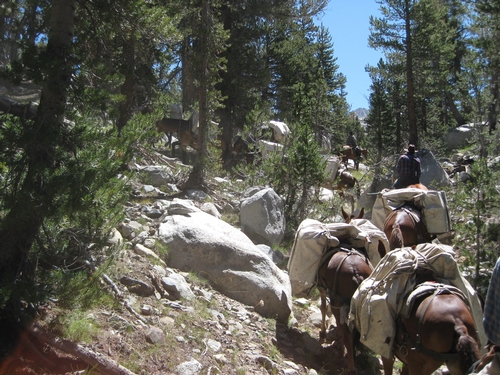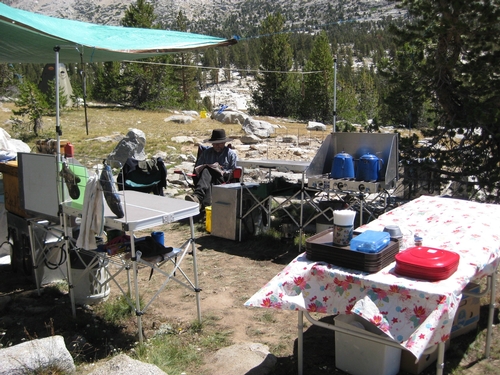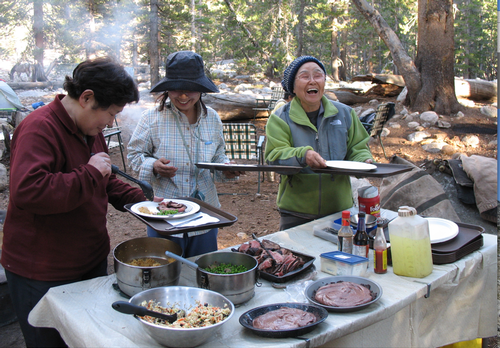Every August, I pack up my saddle, cowboy bedroll, chef’s knife and my vacation hours and head to a pack station high in the eastern Sierra Nevada between Mammoth and Bishop. A couple days later I’m out on trail, usually riding somewhere in the national parks of Kings Canyon, Sequoia or Mt. Whitney, with strings of pack mules in front of me.

The author heading to work
The packers—cowboys who load and manage the mules—and I take paying guests, their gear and our supplies into the back country for days, even weeks at a time. The guests hike or ride with us to each camp, where the packers unload the patient mules and I set up my kitchen. That’s when my real work begins.

The food for each trip is kept in large, lockable, bear-proof boxes with heavy leather straps that hook onto the pack saddles. Perishables are kept in soft coolers in the bear boxes; cans and bottles are padded with other items in cardboard so they don’t break or rattle together and worry the mules. At night I cover the bear boxes with a tarp, then a bear-alarm system of stacked pans.
During the day, when we’re in camp, the bear boxes are kept covered in the shade of pine trees or granite boulders. Our cowboy menus are practical and reflect what food must be eaten soonest: the first dinner is always burgers, the second, chicken. I remove produce from plastic bags, which hasten spoilage, and keep it in brown bags or wrapped in clean dish towels.

A tidy kitchen at midday. The bear box in the sun holds garbage, the wooden box holds cooking utensils.
After 6 years, I have discovered some secrets of back country cooking: people are always very, very hungry from exercising in the high elevations, which are often above 10,000 feet. But even hungry they still appreciate good, well-prepared and well-seasoned food. The difference between a packaged, instant pudding and a slowly steamed, stovetop apple crisp are obvious. Pancakes cooked with thin layers of ripe peaches are tastier than plain ones. And under no circumstances do you overcook the steaks, even when you’re negotiating damp and uncooperative firewood.
The pack station outfitter supplies delicious meat; the thick bacon alone is worth the trip. I grill chops, simmer stews and roast thick cuts of meat that have been deep frozen for days. The hearty meat dishes are not just for tradition; the packers rise well before first light to wrangle the grazing animals, and protein fuels their long days. But our guests are health conscious and like produce as well.
The lettuce that best survives the days of jostling in the bear-proof boxes is iceberg, but salads of iceberg, tomatoes and cucumbers with packaged dressing get downright dull. Instead we serve a popular broccoli salad or my improvised cole slaw, which varies with every trip depending on what I have in my bear boxes. If there is any left over, I put it out when guests are making their sandwiches for lunch the next morning. Although coleslaw in a sandwich is a mess to eat—believe me, I have done so, leaning over my horse’s mane—its crunch and flavors makes the sandwiches zing.

Guests from Japan helping themselves to grilled lamb served with cole slaw.
Broccoli Salad
Serves 6-8
1 head broccoli
1 small red onion
½ cup dry roasted sunflower seeds
Dressing: mayonnaise, apple cider vinegar, dry thyme, salt and pepper
Trim the broccoli into very small florets. Put dressing ingredients in bowl and whisk. The dressing should be thin enough to coat broccoli nicely but not so it puddles in bottom of bowl. Toss dressing over salad. Sprinkle sunflower seeds generously over the top.
Cole Slaw
Serves 8-10 as a side dish; exact amounts are not critical
green cabbage
red cabbage, if available
2 zucchini, green skins primarily
3 carrots
slivered or sliced toasted almonds
dried cranberries
green or red pepper
red onion
Optional: a can sliced water chestnuts or crushed pineapple
Dressing: Mayonnaise, apple cider vinegar and white wine vinegar (I use both), celery seed (important), salt and pepper to taste. Add mayo and vinegar so dressing is creamy, not gloppy.
With a sharp chef’s knife, thinly slice the cabbage. Pick through and remove any thick white ribs, then dice cabbage as finely as you have patience to do. Grate carrots and zucchini skins (I feed the soft zucchini centers to the mules). Finely dice green pepper and red onion. Toss vegetables together and add cranberries and nearly all the almonds. Look at the balance of the salad: you want a cranberry and a few almonds in nearly every bite. Whisk dressing together and pour over slaw, tossing to coat. Set aside in a cool place and just before serving, sprinkle with remaining almonds.